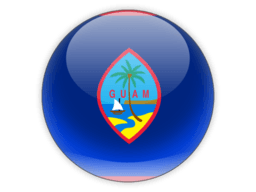
Regions of Guam
Explore 19 regions
Cities of Guam
Discover 21 cities across 19 regions
Agana Heights(1)
Barrigada(1)
Chalan Pago-Ordot(1)
Hagatna(1)
Inarajan(1)
Mangilao(1)
Merizo(1)
Mongmong-Toto-Maite(1)
Santa Rita(1)
Sinajana(1)
Talofofo(1)
Umatac(1)
Guam is an organized unincorporated territory of the United States located in the Western Pacific Ocean. It is the largest and southernmost of the Mariana Islands, and its closest neighbors are the Northern Mariana Islands to the north, and Micronesia to the west. The island has a total land area of approximately 210 square miles (549 square kilometers), and its population is around 170,000 people.
Guam has a tropical climate with high temperatures and humidity throughout the year, and occasional typhoons. The island's economy is heavily dependent on tourism and the United States military presence, with several military bases located on the island. The main languages spoken on Guam are English and Chamorro, an indigenous language.
Guam has a rich history, with evidence of human habitation dating back more than 4,000 years. The island was colonized by Spain in the 17th century and remained a Spanish colony until it was ceded to the United States in 1898 following the Spanish-American War. Guam was occupied by Japan during World War II, and it was recaptured by the United States in 1944. In 1950, Guam became an organized unincorporated territory of the United States.
Telephone Code
671
Local Emergency Phone
911 (USA)
Vaccinations
See WHO recommendations
Climate
Tropical marine; generally warm and humid, moderated by northeast trade winds; dry season (January to June), rainy season (July to December); little seasonal temperature variation
Currency (Code)
US $ (USD)
Electricity/Voltage/Plug Type(s)
110 V / 60 Hz / plug types(s): A, B
Major Languages
English, Filipino, Chamorro, other Pacific island languages, Asian languages
Major Religions
Christian (predominantly Roman Catholic) 94.2%, folk religions 1.5%, Buddhist 1.1%
Potable Water
Yes
International Driving Permit
Suggested for non-US citizens.
Road Driving Side
Right
Tourist Destinations
Chamorro Village; Guam Museum; Dulce Nombre de Maria Cathedral Basilica; Fort Apugan; Latte Stone Park; Ritidian Point; Two Lover's Point; War in the Pacific National Historic Park (includes Apaca Point)
Major Sports
Soccer, basketball, rugby
Cultural Practices
Respect for family, community, and elders are major components of traditional Chamorro culture. Island culture has also been heavily influenced by both Spanish and American customs. The latter are pervasive in government and the media. Korean, Micronesian, Filipino, Chinese and Japanese immigrants have also enriched Guam's culture.
Tipping Guidelines
Tipping is common practice in the same way as it is in the US.
Souvenirs
Marmar flower headbands, woven baskets, shell necklaces and beaded jewelry, sarongs, machetes with carved wooden handles, natural beauty products
Traditional Cuisine
Kelaguen — a seafood, fish, or meat dish served either as a main course, appetizer, or side dish; the ingredients are typically marinated in a combination of lemon juice, salt, and hot peppers and sometimes enriched with grated fresh coconut
Geography
Area
total: 544 sq km
land: 544 sq km
water: 0 sq km
Climate
tropical marine; generally warm and humid, moderated by northeast trade winds; dry season (January to June), rainy season (July to December); little seasonal temperature variation
Natural resources
aquatic wildlife (supporting tourism), fishing (largely undeveloped)
People and Society
Population
169,330 (2023 est.)
Ethnic groups
Chamorro 37.3%, Filipino 26.3%, White 7.1%, Chuukese 7%, Korean 2.2%, other Pacific Islander 2%, other Asian 2%, Chinese 1.6%, Palauan 1.6%, Japanese 1.5%, Pohnpeian 1.4%, mixed 9.4%, other 0.6% (2010 est.)
Languages
English 43.6%, Filipino 21.2%, Chamorro 17.8%, other Pacific island languages 10%, Asian languages 6.3%, other 1.1% (2010 est.)
Religions
Christian (predominantly Roman Catholic) 94.2%, folk religions 1.5%, Buddhist 1.1%, other 1.6%, unaffiliated 1.7% (2020 est.)
Population growth rate
0.13% (2023 est.)
Government
Government type
unincorporated organized territory of the US with local self-government; republican form of territorial government with separate executive, legislative, and judicial branches
Capital
name: Hagatna (Agana)
Economy
Economic overview
small Pacific island US territorial economy; upper income, tourism-based economy; hard-hit by COVID-19 disruptions; relaunched many industries via vaccination tourism; domestic economy relies on multiple military bases; environmentally fragile economy
Real GDP (purchasing power parity)
$5.793 billion (2016 est.)
Real GDP per capita
$35,600 (2016 est.)
Agricultural products
fruits, copra, vegetables; eggs, pork, poultry, beef
Industries
national defense, tourism, construction, transshipment services, concrete products, printing and publishing, food processing, textiles
Exports
$1.124 billion (2016 est.)
Exports - partners
South Korea 31%, Hong Kong 27%, Taiwan 18%, Philippines 7% (2019)
Exports - commodities
scrap iron, electric batteries, gas turbines, scrap copper, beauty products (2019)
Imports
$2.964 billion (2016 est.)
Imports - partners
Singapore 33%, Japan 21%, South Korea 18%, Hong Kong 9%, Malaysia 6% (2019)
International Airports in Guam
Discover 1 major airports serving Guam
Mark Guam as Visited
Add Guam to your personal travel map and track your journey around the world. Share your adventures and see your progress grow!